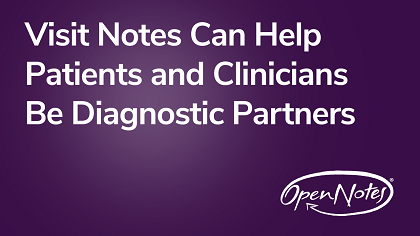
Earlier this month, Charlotte Blease, PhD, a research fellow at Beth Israel Deaconess Medical Center and Sigall Bell, MD, an Associate Professor of Medicine at Harvard Medical School and Director of Patient Safety and Discovery at OpenNotes, published a new article on the role that patients’ access to visit notes might play in improving diagnostic accuracy. The study, published in Diagnosis, the official journal of the Society to Improve Diagnosis in Medicine (SIDM), proposes that patients may be the most underutilized resource for mitigating diagnostic error.
Diagnostic excellence is now a national priority. Errors resulting from missed, delayed, or wrong diagnoses are estimated to occur in 10–15% of ambulatory and inpatient encounters, leading to serious harm in about half of such instances. Traditionally, researchers defining diagnostic accuracy and the causes that lead to diagnostic errors turned their attention toward factors affecting doctors’ cognition and clinic environments. The two authors, however, set their focus on patients.
“Patients hold a unique body of knowledge about their health and healthcare experience,” said Bell. “And in recent years, evidence started suggesting that engaging them in the diagnostic process is key to improving patient safety. However, proven ways to do so are scarce.”
“Research lead by the OpenNotes team suggests that shared clinician notes, known increasingly as ‘open notes,’ can be powerful tools for enhancing engagement,” added Blease. “That’s why we chose to look at recent findings from patient surveys about sharing visit notes with patients online.”
Drawing on these survey results, the authors suggest sharing visit notes with patients might enhance diagnostic processes in three ways: 1. by avoiding delays and missed diagnoses by helping patients promptly follow-up on recommended tests, results, and referrals; 2. by identifying documentation errors that may be actual or possible safety concerns or misdiagnosis; and, 3. by strengthening the relationship between patient and clinician, creating a stronger partnership between the two.
The paper considered the potential limitations of the study and proposed four steps to take the findings further. “There is a need for greater clarity, organizational structure and educational support, to establish pathways for the follow-up of test results and feedback on potential documentation errors,” said Bell. “Well advertised, patient friendly systems should invite patient feedback, avoid overwhelming already over-burdened clinicians, and ensure patients are not frustrated by the lack of responses to those they report.”
The authors concluded that open notes are an effective and scalable way to give patients a defined role in collaborative safety efforts. By allowing patients to access the information any time and at their convenience, research shows that they better remember what was discussed during the visit—including diagnostic tests or procedures the doctor recommends. Keeping patients and doctors connected in the space between visits, where many ambulatory diagnostic errors occur, may prove critical.



